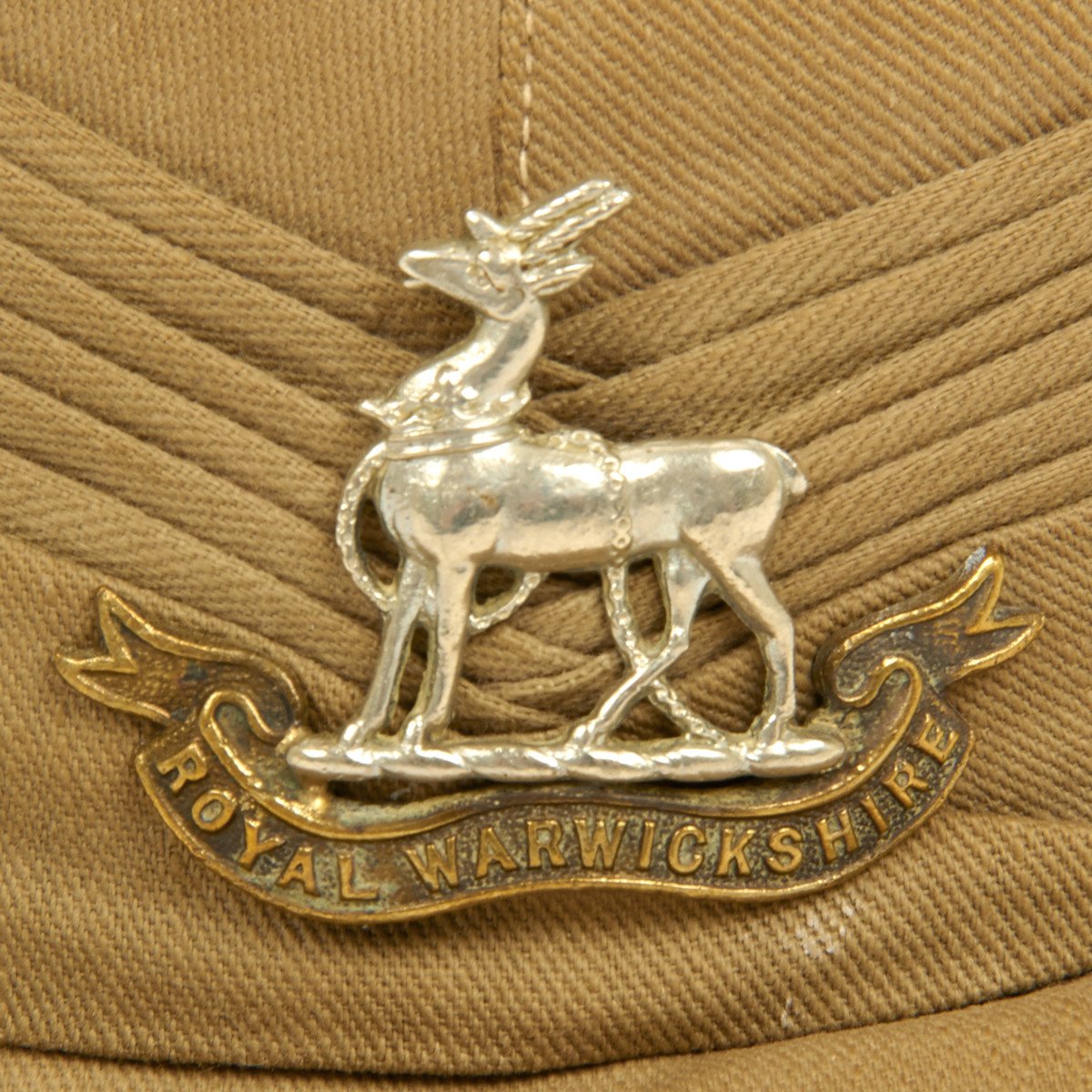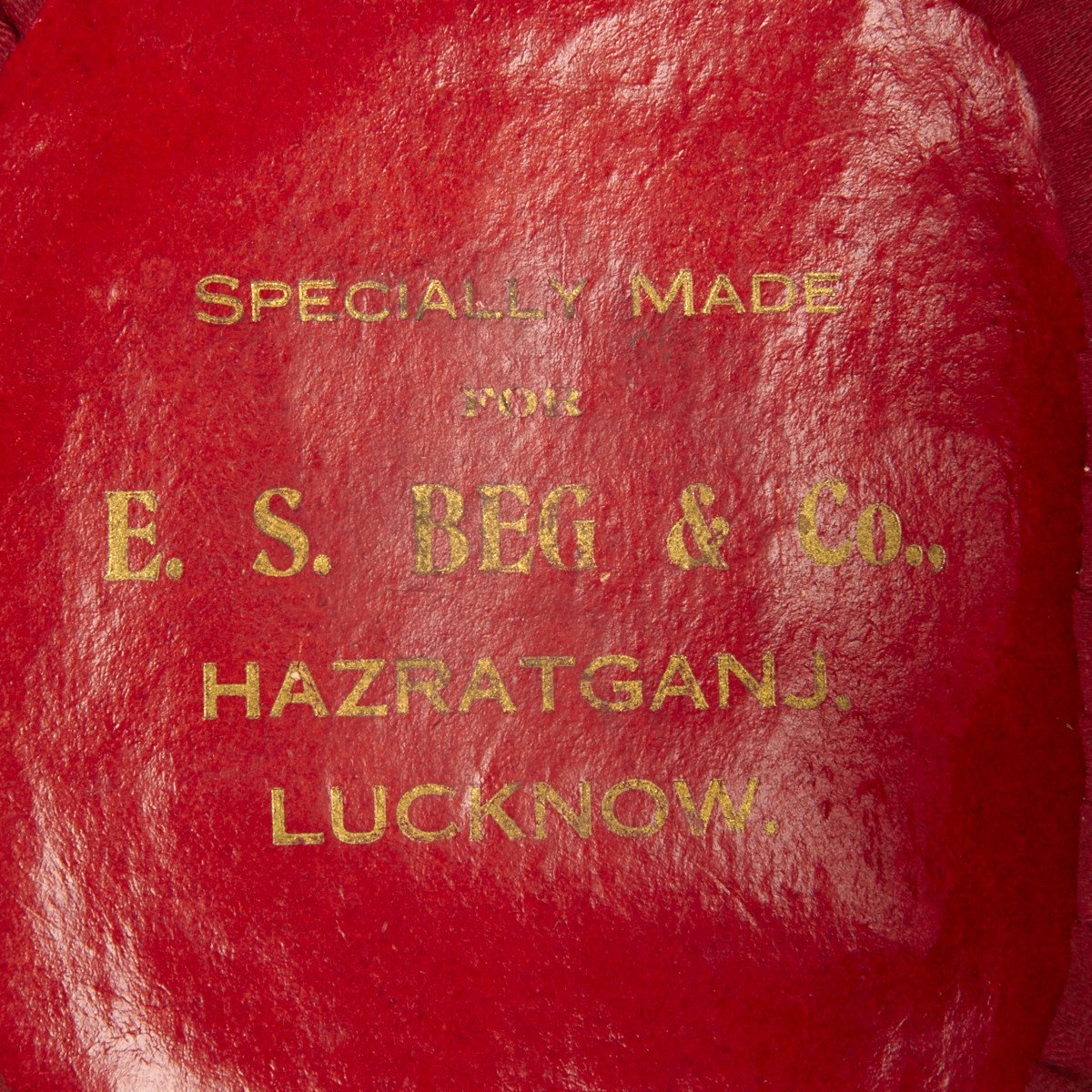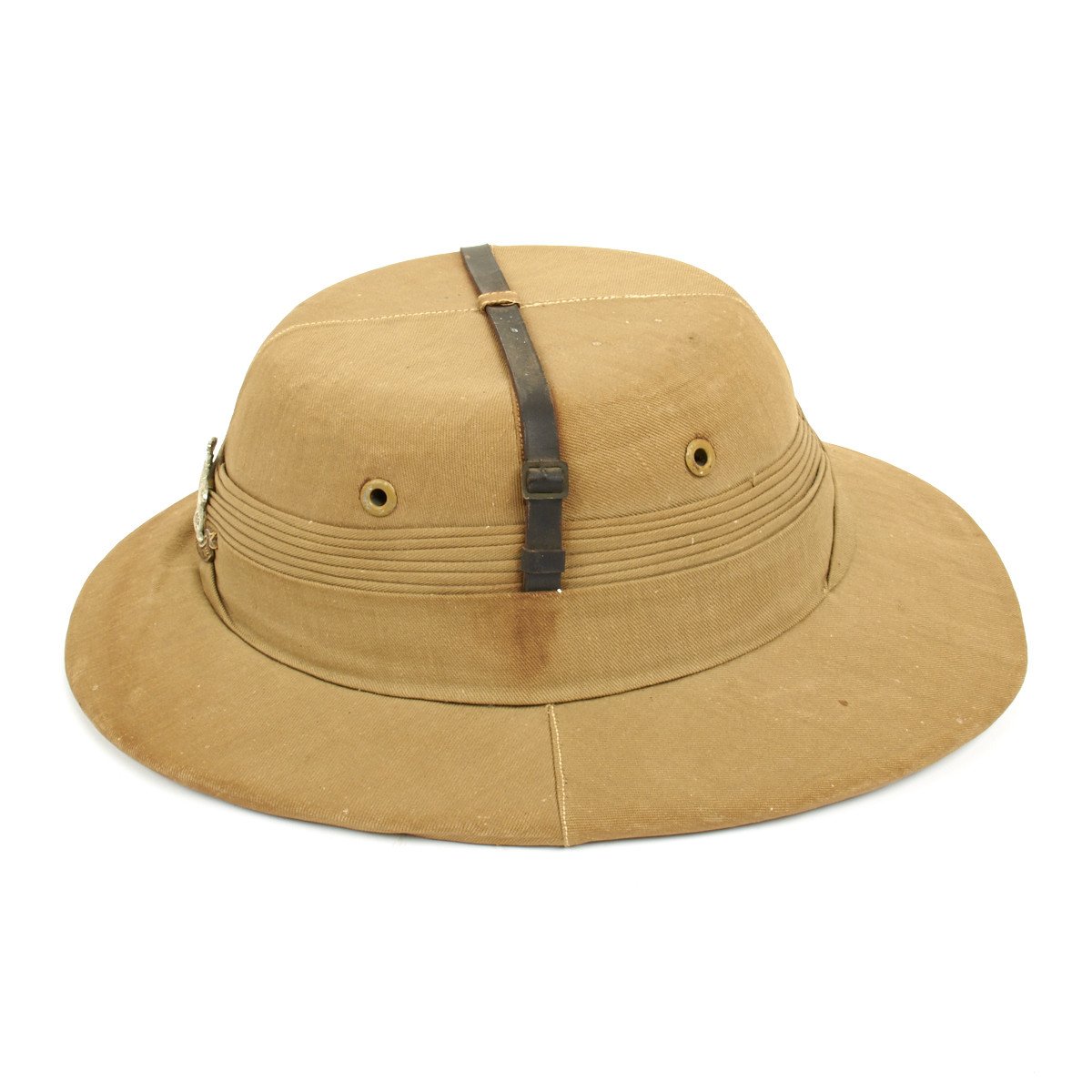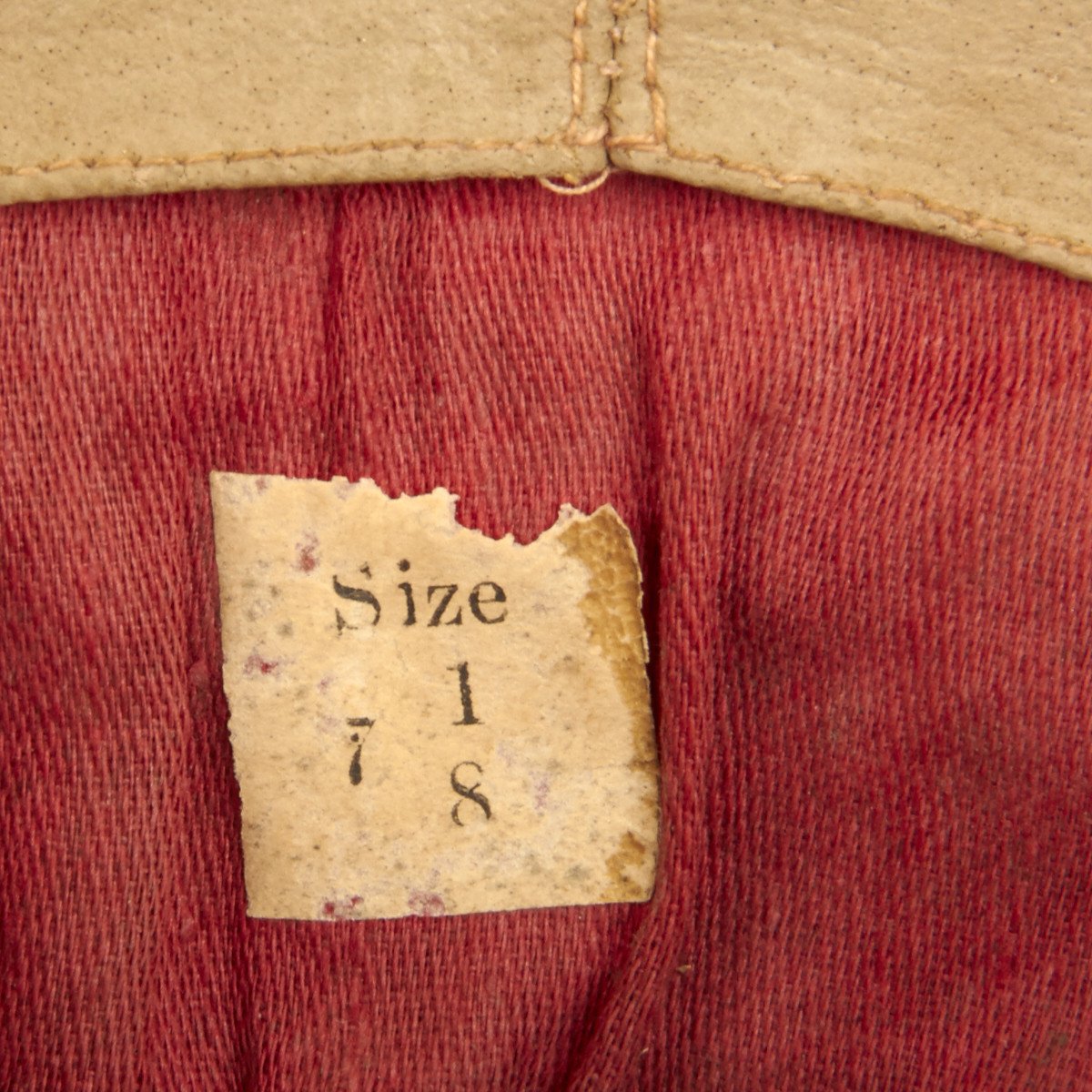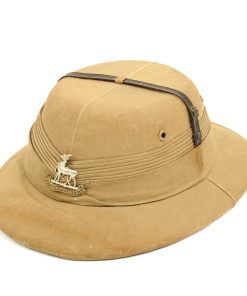Original British WWII Bombay Bowler Pith Helmet of the Royal Warwickshire Regiment Original Items
$ 295,00 $ 118,00
Original Item: Only One Available. Developed for WW2 this is a cork pith helmet with a most wonderful maker’s label inside the crown that reads:
SPECIALLY MADE
FOR
E.S. BEG 7 CO.
HAZRATGANJ
LUCKNOW.
This is a completely original WWII production example with leather top strap and pugaree (crown wrap) bearing the brass helmet badge of the Royal Warwickshire Regiment. The chinstrap is absent.
Features of note include the correct khaki color, leather headband with size tag reading 7 1/8 with pleated cotton lining.
Just as worn by officers and men stationed in India and Southeast Asia during WW2.
History of the Royal Warwickshire Regiment during the Second World War:
The 1st Battalion of the regiment had served from 1937-39 on the North West Frontier in British India.[3] Throughout the war the 1st Battalion remained mainly on garrison duties and internal security operations, despite many times being promised a chance to fight in the war and in late 1944 began training for jungle warfare. The battalion only very briefly fought in the final stages of the Burma Campaign under Lieutenant-General Bill Slim, an officer who served with the regiment during the Great War and who led the British Fourteenth Army and took part in Operation Dracula, the capture of Rangoon, with the 4th Indian Infantry Brigade, part of the 26th Indian Infantry Division, in April 1945 but saw little contact with the enemy and, on 20 May, the battalion received orders to prepare to, again, return to India. On the 23rd major J.A. Collins, Officer Commanding ‘A’ Company, led his company against a group of between to 50 and 100 of the enemy, in Tinzeik, and inflicted heavy casualties on them before withdrawing into the jungle. For this action Major Collins was awarded the Military Cross for his leadership, along with Lance Corporal Brooks the Military Medal, and Private McCullum a mention in despatches and the 1st Battalion “earned the commendation of the Division Commander, Major-General Chambers.” ‘A’ Company then rejoined the rest of the battalion in Rangoon, which departed on the 20th, and then moved to Bangalore.
The 2nd Battalion, Royal Warwickshire Regiment, a Regular Army unit, had been serving in England since 1931 and, upon the outbreak of World War II, was serving alongside the 2nd Battalion, Dorset Regiment and 1st Battalion, Queen’s Own Cameron Highlanders in the 5th Infantry Brigade, part of the 2nd Infantry Division. In late September 1939 the battalion was sent overseas to France to join the British Expeditionary Force (BEF) on the Franco-Belgian border, where it remained for many months, not involved in any major engagements. On 5 February 1940, due to official BEF policy, the battalion was exchanged in the brigade for the 7th Battalion, Worcestershire Regiment[7] and transferred to the 144th Infantry Brigade which was attached to the 48th (South Midland) Infantry Division, a Territorial division. Serving in the brigade alongside the 2nd Battalion were the 8th Battalion, Worcestershires and 5th Battalion, Gloucestershire Regiment. The battalion, now under command of Lieutenant Colonel Philip Hicks (an officer of the regiment who would serve with distinction in the war), fought in the Battle of France in May 1940 fighting at the defence of the Escaut, Wormhoudt, where they from the Wormhoudt massacre and fought on the Ypres-Comines Canal during the retreat to Dunkirk, from where they were evacuated to England, most of the remaining men arriving on 1 June 1940. After Dunkirk, the battalion moved, with the rest of the brigade[8] and division, to Somerset to counter a German invasion. In early December, however, the battalion transferred to the 24th Independent Guards Brigade Group, alongside two battalions of Foot Guards, the 1st Scots Guards and 1st Welsh Guards and was not, unlike most of the rest of the Army, committed to beach defence duties.[9] At the time the brigade was stationed in London under command of London District. In September 1942 the battalion transferred to the 185th Infantry Brigade, which was originally assigned as the motorised infantry brigade of the 79th Armoured Division. However, the brigade was then transferred to the 3rd Infantry Division, and landed on D-Day on 6 June 1944 with the first assault on the Normandy beaches and fought from the Battle for Caen and the break out from Normandy to the Rhine crossing. They also took part in the capture of Bremen, the last major action of the North West Europe Campaign. From D-Day until the end of the war the 2nd Battalion, Royal Warwickshire Regiment had lost 286 officers and men killed in action, with nearly another 1,000 all ranks wounded, missing or suffering from exhaustion.
Fast Shipping with Professional Packaging
Thanks to our longstanding association with UPS FedEx DHL, and other major international carriers, we are able to provide a range of shipping options. Our warehouse staff is expertly trained and will wrap your products according to our exact and precise specifications. Prior to shipping, your goods will be thoroughly examined and securely secured. We ship to thousands clients each day across multiple countries. This shows how we're dedicated to be the largest retailer on the internet. Warehouses and distribution centres can be located throughout Europe as well as the USA.
Note: Orders with more than one item will be assigned a processing date depending on the item.
Before shipping before shipping, we'll conduct a thorough inspection of the items you have ordered. Today, the majority of orders will be delivered within 48 hours. The delivery time will be between 3-7 days.
Returns
The stock is dynamic and we cannot completely manage it because multiple stakeholders are involved, including our factory and warehouse. So the actual stock may alter at any time. It's possible that you may not receive your order once the order has been made.
Our policy is valid for a period of 30 days. If you don't receive the product within 30 days, we are not able to issue a refund or an exchange.
You can only return an item if it is unused and in the same state as the day you received it. You must have the item in its original packaging.
Related products
Uncategorized
Uncategorized
Uncategorized
Uncategorized
Australian WWII Owen MK1 Machine Carbine SMG Custom Fabricated Replica with Sling Original Items
Uncategorized
Uncategorized
Uncategorized
Uncategorized
Uncategorized
Uncategorized
Angolan Rebel 1970s era 60mm Inert Display Mortar from Angolan Civil War Original Items
Uncategorized
Uncategorized
Uncategorized
Uncategorized
Uncategorized
Uncategorized
Uncategorized

